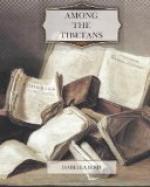The first view, and indeed the whole view of this temple of Wrath or Justice, was suggestive of a frightful Inferno, with its rows of demon gods, hideous beyond Western conception, engaged in torturing writhing and bleeding specimens of humanity. Demon masks of ancient lacquer hung from the pillars, naked swords gleamed in motionless hands, and in a deep recess whose ‘darkness’ was rendered ‘visible’ by one lamp, was that indescribable horror the executioner of the Lord of Hell, his many brandished arms holding instruments of torture, and before him the bell, the thunderbolt and sceptre, the holy water, and the baptismal flagon. Our joss-sticks fumed on the still air, monks waved censers, and blasts of dissonant music woke the semi-subterranean echoes. In this temple of Justice the younger lamas spend some hours daily in the supposed contemplation of the torments reserved for the unholy. In the highest temple, that of Peace, the summer sunshine fell on Shakya Thubba and the Buddhist triad seated in endless serenity. The walls were covered with frescoes of great lamas, and a series of alcoves, each with an image representing an incarnation of Buddha, ran round the temple. In a chapel full of monstrous images and piles of medallions made of the ashes of ‘holy’ men, the sub-abbot was discoursing to the acolytes on the religious classics. In the chapel of meditations, among lighted incense sticks, monks seated before images were telling their beads with the object of working themselves into a state of ecstatic contemplation (somewhat resembling a certain hypnotic trance), for there are undoubtedly devout lamas, though the majority are idle and unholy. It must be understood that all Tibetan literature is ‘sacred,’ though some of the volumes of exquisite calligraphy on parchment, which for our benefit were divested of their silken and brocaded wrappings, contain nothing better than fairy tales and stories of doubtful morality, which are recited by the lamas to the accompaniment of incessant cups of chang, as a religious duty when they visit their ‘flocks’ in the winter.
The Deskyid gonpo contains 150 lamas, all of whom have been educated at Lhassa. A younger son in every household becomes a monk, and occasionally enters upon his vocation as an acolyte pupil as soon as weaned. At the age of thirteen these acolytes are sent to study at Lhassa for five or seven years, their departure being made the occasion of a great village feast, with several days of religious observances. The close connection with Lhassa, especially in the case of the yellow lamas, gives Nubra Buddhism a singular interest. All the larger gonpos have their prototype in Lhassa, all ceremonial has originated in Lhassa, every instrument of worship has been consecrated in Lhassa, and every lama is educated in the learning only to be obtained at Lhassa. Buddhism is indeed the most salient feature of Nubra. There are gonpos everywhere, the roads are lined by miles of




